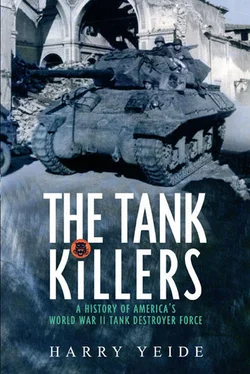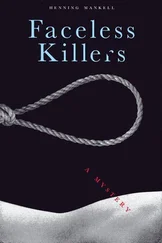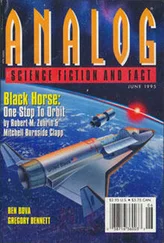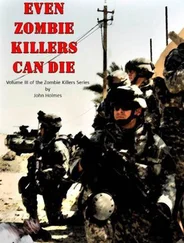By 1939, an updated version of the U.S. Army’s manual, now entitled Antimechanized Defense (Tentative) , advocated an antitank defense in depth, with divisional antitank battalions that were to be both motorized and supplied with a reconnaissance element so that they could mass quickly against armored thrusts. Yet while thinking was beginning to respond to the demands of the looming modern battlefield, the Army’s organization and equipment were not. When the Germans overran Poland in 1939, the Army had neither antitank units nor an antitank gun in production. In 1940, a copy of the German 37mm antitank gun—already nearing obsolescence—was hurriedly produced. 3McNair recognized this deficiency and in June 1940 told the War Department General Staff that the greatest problem confronting it was to find a way to stop armored divisions, and that a flat-trajectory gun heavier than either the 37mm or 75mm guns in use would be necessary for that purpose. 4
Stunned by the Wehrmacht’s romps through Poland and France, Congress found the money, and the Army recreated an Armored Force on 10 July 1940. 5Induction of the National Guard and Reserves followed, along with implementation of a peacetime draft. The rapid German victories, meanwhile, raised fundamental questions about the soundness of a tank defense based primarily on antitank guns, which the highly respected French Army had tried without success. The fact that most American field artillery officers charged with antitank defense had never even seen a tank in action did not help matters. 6Nor did the fact that antiaircraft artillery regiments had not yet practiced antitank fire. 7
McNair, for one, kept the faith. In July 1940, he argued in a memo: “When the armored vehicle faces the antitank gun, the combat is essentially a fire action between a moving gun platform in plain view and a small, carefully concealed, stationary gun platform. The struggle is analogous to that between ships and shore guns, and there is no question that the shore guns are superior—so much so that ships do not accept such a contest…. If the gun outmatches the tank, then not only is the gun superior to the tank in antitank defense, but employing armored units against other armored units positively should be avoided whenever possible. The gun, supported properly by foot troops, should defeat hostile armored units by fire and free the friendly armored units for action against objectives which are vulnerable to them.” 8
McNair’s arguments were to shape the Tank Destroyer and Armored Forces in fundamental ways. The U.S. Army was to enter the war believing that tanks should not fight tanks, and it selected its equipment on the basis of that doctrinal assumption.
In August 1940, McNair rejected passive antitank defense and first proposed the establishment of mobile antitank groups of three battalions each that would be able to rush to confront a mechanized attack. The next month, the War Department issued a training circular that directed that units concentrate their antitank guns in a mobile reserve and deploy a minimum in fixed initial positions. 9In April 1941, U.S. Army Chief of Staff General George Marshall ordered his operations chief (G-3) to consider the creation of “highly mobile antitank-antiaircraft units as Corps and Army troops for use in meeting mechanized units.” These elements would be in addition to organic antitank weapons. 10
The Army, meanwhile, had become mired in a debate over who should manage antitank matters—the infantry or the field artillery (the newly created quasi-branch of armor was uninterested and was being told it should not fight tanks in any event)—and how. The Army authorized antitank companies to the infantry divisions in autumn of 1940. Nonetheless, the next spring McNair—by now the chief of staff at General Headquarters (GHQ)—was moved to complain, “It is beyond belief that so little could be done on the [antitank] question, in view of all that is happening abroad.” He accused the Army of apathy. 11
Marshall, in May 1941, moved to cut the Gordian knot; he ordered his G-3 to take charge of antitank development. The G-3, on Marshall’s instructions, immediately established a Planning Branch under LtCol Andrew D. Bruce. This staff, which was to form the core of the tank destroyer brain trust, reaffirmed the need for divisional antitank battalions.
The Army finally ordered the establishment of those units on 24 June—two days after Hitler’s panzer spearheads rolled into the Soviet Union! The first battalions were a heterogeneous lot, but they typically consisted of three to five batteries withdrawn from the field artillery and equipped with 75mm, 37mm, or simulated guns. 12As of the end that month, only a handful of antitank battalions existed: the 93d at Fort Meade, Maryland; the 94th at Fort Benning, Georgia; the 99th at Fort Lewis, Washington; and battalions 101 through 105, which had been inducted into Federal service during the mobilization of the National Guard in January and February of 1941. 13
Also in June, GHQ launched the first of a series of large-scale maneuvers. In the first corps-versus-corps wargames, held in Tennessee, MajGen George Patton Jr. deployed his 2d Armored Division in highly successful cavalry-style slashing maneuver. The units opposing him, however, had virtually no antitank capability. 14Indeed, after 10 July, when the 28th Infantry Division Antitank Battalion (provisional) was formed, the men exercised using 3/4-ton weapons carriers as prime movers, with towed “guns” made out of miscellaneous pieces of pipe, wood, and other materials. 15And thousands of miles away in the real war, German antiaircraft and other artillery on the Egyptian-Libyan frontier that same month played a major role in the destruction of more than two hundred British tanks, which caught the attention of the War Department intelligence chief (G-2). 16
The next round of maneuvers would be different. On 8 August, and in line with his proposal of one year earlier, McNair ordered Third Army to organize three regiment-sized provisional antitank groups. Each consisted of three antitank battalions (armed with 37mm and 75mm guns), a scout car reconnaissance platoon, three engineer platoons, and three rifle platoons. The groups were to be attached at the field-army level and were trained to execute an “offensive role,” including vigorous reconnaissance, preemptive contact with enemy armor, and destruction of enemy tanks with massed gunfire. 17This rough mix of components and doctrinal orientation would soon provide the foundation for the separate tank destroyer battalions.
The debates were not over, but the die was cast. McNair continued to champion a dramatic expansion of the antitank program. 18On 18 August, the War Department released a detailed memorandum calling for the formation of two hundred twenty antitank battalions, fifty-five of which were to be organic to the divisions, fifty-five pooled at the corps and army levels, and one hundred ten allocated as GHQ assets. McNair praised the boldness of the proposal but withheld his concurrence because he objected to the War Department’s plans to subordinate the antitank units to the Armored Force; to disperse some antitank battalions among divisions, corps, and armies; and to create two hundred twenty battalions, a number he judged excessive. McNair eventually had his way on almost every point. 19
In September, Third Army faced Second Army in Louisiana in the largest field exercises in the nation’s history. Two types of makeshift proto-tank destroyers were employed. The first consisted of a 3/4-ton truck with a railroad tie secured across the bed; a 37mm gun with its wheels removed was fixed to the tie and its split tail wired to the corners of the truck bed. 20The second mounted a 75mm gun on a 1-1/2-ton truck. 21Antitank guns—although mostly from the infantry’s organic defenses—stymied Second Army’s I Armored Corps at almost every turn, to McNair’s obvious delight. The rules, however, now gave antitank weapons a tremendous advantage, and armor’s difficulties derived in large part—as subsequent experience would show—from trying to operate with all-tank formations. 22In other words, the maneuvers gave very little idea how American antitank elements might be expected to perform against Germany’s combined-arms blitzkrieg.
Читать дальше







